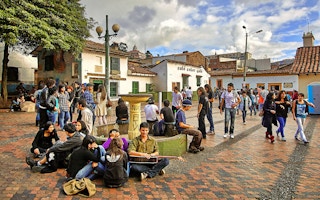By 2050, nearly 70 per cent of the world’s population will reside in cities, increasing the size of the world’s urban population by more than two-thirds. Cities will need to focus on building the right things to ensure this growth happens sustainably — so how can they pay for it?
Recognising that finance is a core issue of sustainable urban development and one of cities’ biggest challenges, the International Development Finance Club (IDFC) hosted a side event on this topic at Habitat III in Quito.
The discussion, which featured leaders from CAF-Development Bank of Latin America (CAF), Agence Française de Développement (AFD), Japan International Cooperation Agency (JICA) and the National Planning Department of Colombia (DNP) highlighted four key insights about financing sustainable cities. In short, development finance institutions (DFIs) can play a big role in bridging the funding gap, but only with the right partners and policies in place:
1. Growing cities should seek better outcomes, not just more finance.
A long-term plan for a city with at least a 10- to 15-year horizon sets the stage for how it develops and what projects will ultimately need financing. Ultimately, it’s not just about the money, but what cities build with it.
The New Urban Agenda adopted in Quito provides cities with standards for sustainable urban development that they can incorporate into these plans, and the Sustainable Development Goals and countries’ national climate plans (NDCs) provide still more important considerations. One critical characteristic of these plans, as noted by Simón Gaviria, chief director of the DNP, is that they should serve citizens’ rather than the government’s needs.
DFIs can help cities develop strong and effective plans. For instance, Koki Hirota, JICA’s chief economist, shared how JICA has supported hundreds of master plans for cities undergoing rapid urbanisation in an effort to support development while preventing future inefficiencies in delivering services to city populations.
2. Development finance institutions are ready to unstick cities struggling with project preparation.
Once plans are in place, cities often need help with feasibility studies and preparation to get projects like bus-rapid transit systems or building efficiency retrofits to a stage where they are “bankable,” or financially viable and able to secure financing from third-party sources. However, city governments, which can be good at designing broader city plans, often hit a wall when it comes to creating a pipeline of bankable projects.
DFIs are helping to address this challenge. As Rémy Rioux, AFD’s CEO, explained, AFD launched its 100 cities/100 Climate Projects initiative last year at COP21, which provides grants to cover project preparation costs and then lends to projects once they are developed.
3. Scaling can happen only if local financial institutions and agencies play a prominent role.
Local institutions like local commercial banks and mayor’s offices understand the local financial system, players, challenges and opportunities. So it’s important that national and international institutions work with the local players. In light of this, the DNP is making an effort to collect data to better understand Colombia’s cities.
DFIs can collaborate with local government and financial institutions to provide additional funds and knowledge. One approach is to provide a loan to a local financial institution for “on-lending,” where the local financial institution uses the borrowed money to provide loans to its clients, which in this case, are cities.
4. The best outcomes come from partnerships and coordination with a range of actors.
The involvement of mayors, national planning agencies, private sector developers and investors, and civil society groups are all needed to develop and finance sustainable cities. DFIs can bring financing to the table, and they can also help enhance coordination between these different actors.
For example, in CAF’s Cities with a Future project in Guayaquil, Ecuador, CAF’s financing for housing, transport, water and sanitation programmes helped transform the city and improve quality of life of its citizens. The programme involved strong coordination with multiple actors, including the mayor, city planners, community organisations, local agencies, private sector operators and utility companies.
“
Development finance institutions can play a big role in bridging the funding gap, but only with the right partners and policies in place.
A need for further innovation
While DFIs are already doing much to support sustainable urban development, there’s room for more innovation. Part of this involves further exploration of instruments and models that would support investments in sustainable urban services, like guarantees to de-risk projects, bonds to raise debt financing from pension funds, or public-private partnerships to capture land value.
Another area involves direct engagement with cities. DFIs often ask cities to provide a guarantee from the national government (ensuring that payment obligations will be met) before providing them with finance; this can cause delays or limit cities’ options if the national government refuses. IDFC members like AFD do not have this requirement. Changing internal policies to allow DFIs to channel funds directly to city governments would open new doors for collaboration.
As underscored by Enrique García, CEO of CAF, during the discussion, DFIs are looking to play a catalytic role in creating sustainable cities. The hope is that with these innovations and the continued support of DFIs, cities in developing countries can grow and thrive for generations to come.
Giulia Christianson is Associate for the Climate Finance project within World Resource Institute’s Finance Center, and Aniruddha Dasgupta is the Global Director of the World Resource Institute’s Ross Center for Sustainable Cities. This post was republished from the WRI blog.











